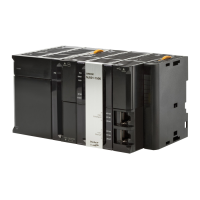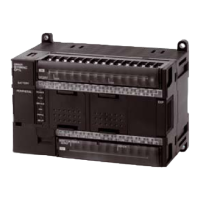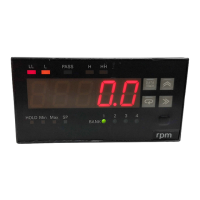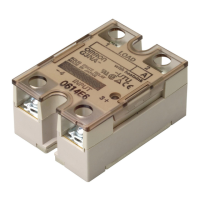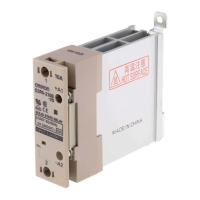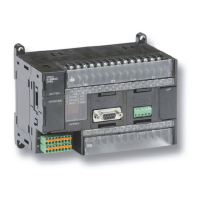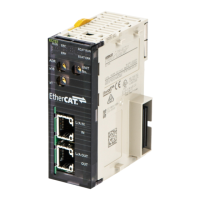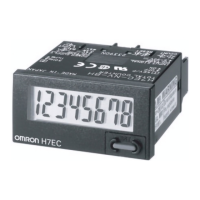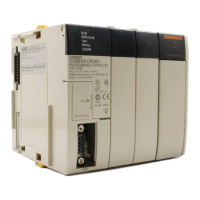Do you have a question about the Omron SYSMAC CP Series and is the answer not in the manual?
| Manufacturer | Omron |
|---|---|
| Mounting | DIN Rail |
| Category | Programmable Logic Controller (PLC) |
| Programming Languages | Function Block Diagram, Structured Text, Sequential Function Chart, Instruction List |
| Communication Protocols | EtherNet/IP, DeviceNet, CompoNet, RS-232C, RS-485 |
| I/O Points | 10 to 160 |
| Power Supply | 100-240 VAC or 24 VDC |
| Operating Temperature | 0°C to 55°C |
| Humidity | 10% to 90% (non-condensing) |
| Vibration Resistance | 10 to 57 Hz, 0.075 mm amplitude |
| Shock Resistance | 147 m/s², 3 times in each direction (X, Y, Z) |
User's Manual for CP2E CPU Unit Software, covering its features, operation, and programming.
This manual, covering software specifications, operation, memory, programming, and Ethernet.
Describes internal memory types and stored data.
Explains CPU Unit operation and operating modes.
Covers basic information on designing ladder programs for the CP2E.
Details the types of I/O memory areas and their usage.
Lists and describes built-in functions and their allocation.
Explains interrupts, including input and scheduled interrupts.
Details high-speed counter inputs, interrupts, and frequency measurement.
Covers positioning functions like trapezoidal control and jogging.
Explains communications with PTs, general components, Modbus, etc.
Covers built-in Ethernet function, specifications, and settings.
Explains the use of CX-Programmer for creating, transferring, and debugging programs.
Precautions related to proper unit setting, DIP switches, DM area initialization, and program checking.
Details the features of the SYSMAC CP2E Programmable Controller package.
Outlines the general steps for setting up and operating the CP2E.
Describes the composition of internal memory in the CPU Unit.
Explains how memory is backed up using RAM, non-volatile RAM, and Flash Memory.
Lists CPU Unit memory areas and the data stored in each.
Provides an overview of CPU Unit operation and power interruption behavior.
Explains the CPU Unit's processing cycle, overhead processing, I/O refresh, and peripheral servicing.
Describes the three operating modes: PROGRAM, MONITOR, and RUN.
Details the backup process for memory areas like programs and DM Area.
Explains the configuration of built-in memory for programs and data.
Describes automatic backup and restoration of programs and parameters.
Provides basic information on ladder programming for CP2E CPU Units.
Explains the structure of user programs, including programs, tasks, and sections.
Covers basic concepts of ladder programming, including execution order.
Details how function blocks can be used in programming for reusability.
Explains the structure of instructions, operands, variations, and execution conditions.
Highlights special program sections and combinations for control.
Describes I/O memory areas including CIO, User, and System Areas.
Details the CIO Area, User Areas (W, H, D, T, C, IR, DR), and System Areas (A, Flags, Pulses).
Explains the Holding Area for retaining content during mode switches and power interruptions.
Details the DM Area for general data storage and manipulation, including backup.
Describes Index Registers for indirect addressing of memory.
Details how input and output bits are allocated to the CPU Unit.
Explains how I/O bits are allocated to expansion units.
Details various settings for startup, timing, interrupts, and communications.
Covers settings for startup data, operating modes, and process execution.
Covers communication settings for serial ports.
Details communication settings for RS-485 serial ports.
Covers settings for high-speed counters and interrupt inputs.
Details base and origin search settings for pulse output 0.
Covers base and origin search settings for pulse output 1.
Details base and origin search settings for pulse output 2.
Covers base and origin search settings for pulse output 3.
Explains settings for the built-in Ethernet port and FINS/TCP.
Lists and describes the functions integrated into CP2E CPU Units.
Outlines the steps for utilizing the CP2E's integrated functions.
Explains how I/O terminals are allocated for various functions.
Explains how to select functions via PLC Setup for optimal terminal usage.
Details the allocation of input terminals for various functions.
Explains the allocation of output terminals for various functions.
Describes quick-response inputs for reading short signals.
Explains the function of quick-response inputs and their pulse width conditions.
Details the steps for setting up and using quick-response inputs.
Explains the concept of interrupts and their processing.
Defines interrupts and categorizes them into input, scheduled, and high-speed counter interrupts.
Details how input interrupts can be executed when built-in inputs change state.
Explains the basic function of input interrupts.
Outlines the procedure for setting up and using input interrupts.
Explains how to execute interrupt tasks at fixed time intervals.
Defines scheduled interrupts and their timing mechanism.
Details the steps for setting up and using scheduled interrupts.
Covers task priority, related auxiliary area, and duplicate processing.
Introduces high-speed counters for measuring pulse signals and their applications.
Explains the purpose and applications of high-speed counters.
Details the steps for enabling and using high-speed counters.
Outlines the procedure for setting up and using pulse outputs.
Outlines the procedure for setting up and using interrupt feeding.
Outlines the procedure for performing origin searches.
Outlines the procedure for setting pulse output port and assigning terminals.
Outlines the procedure for connecting the CP2E CPU Unit and PT.
Outlines the procedure for wiring, PLC setup, and creating ladder programs.
Outlines wiring, PLC setup, and DM fixed allocation for Modbus-RTU.
Outlines wiring, PLC setup, and starting communications for serial PLC links.
Outlines wiring, PLC setup, and sending commands from the host.
Outlines wiring, PLC setup, and automatic response without ladder program.
Details Auto IP, same segment, multiple segments, and dynamic IP connections.
Covers the startup procedure, PLC setup, basic settings, and communications test.
Details the procedure for setting up Ethernet in PLC Setup using CX-Programmer.
Details the steps for using FINS/UDP and FINS/TCP services.
Details the steps for setting parameters and requesting socket services.
Outlines the steps for manually performing automatic clock adjustment.
Outlines the steps for setting up temperature sensors and PID parameters.
Explains the function to save specified DM Area words to Flash Memory.
Covers saving DM Area data to Flash Memory and restoring it.
Outlines the steps for backing up and restoring DM data.
Covers the procedure for installing and setting up analog option boards.
Explains the procedure for using analog option boards.
Outlines the steps for mounting, connecting, setting, and programming analog option boards.
Introduces CX-Programmer as the application for creating and operating ladder programs.
Describes the CX-Programmer's capabilities for program creation, setup, and monitoring.
Details the step-by-step process of using CX-Programmer.
Guides on inputting, saving, and editing ladder programs.
Covers creating a new project and inputting ladder instructions.
Guides on establishing online connection and transferring programs.
Explains how to establish an online connection between CX-Programmer and CP2E.
Guides on transferring ladder programs and PLC setup data.
Explains how to start operation by setting RUN mode.
Covers monitoring status, force-setting/resetting bits, and online editing.
Covers instructions for high-speed counters and pulse outputs like INI, CTBL, SPED, PLS2, ACC, IFEED, ITPL, PWM, ORG.


